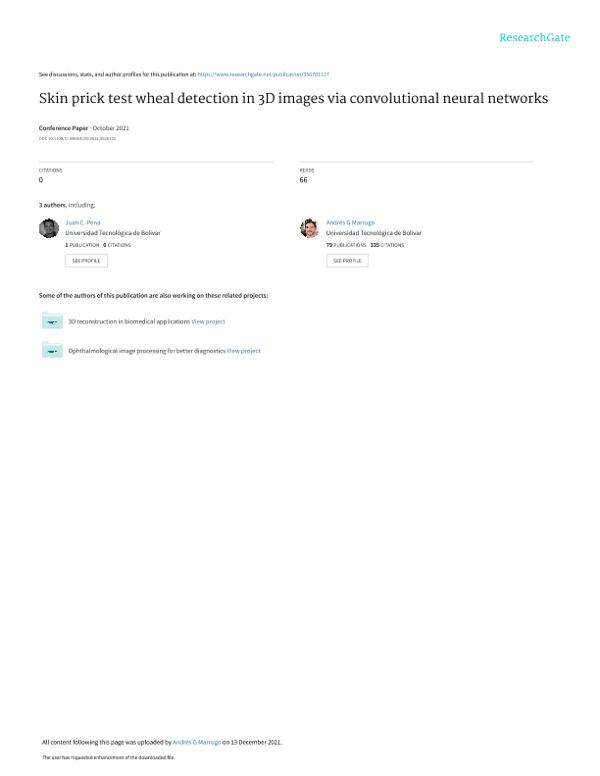Mostrar el registro sencillo del ítem
Skin prick test wheal detection in 3D images via convolutional neural networks
| dc.contributor.author | Pena, Juan C. | |
| dc.contributor.author | Pacheco, Jose A. | |
| dc.contributor.author | Marrugo Hernández, Andrés Guillermo | |
| dc.date.accessioned | 2022-04-06T13:07:09Z | |
| dc.date.available | 2022-04-06T13:07:09Z | |
| dc.date.issued | 2021-10-01 | |
| dc.date.submitted | 2022-04-05 | |
| dc.identifier.citation | Pena, Juan & Pacheco, Jose & Marrugo, Andrés. (2021). Skin prick test wheal detection in 3D images via convolutional neural networks. 1-4. 10.1109/CI-IBBI54220.2021.9626125. | spa |
| dc.identifier.uri | https://hdl.handle.net/20.500.12585/10658 | |
| dc.description.abstract | The skin prick test (SPT) is performed to diagnose different types of allergies. This medical procedure requires measuring the size of the skin wheals that appear when the test is performed. However, the manual measurement method is cumbersome and suffers from intraand inter-observer errors. Thus, multiple approaches have been developed to improve the reproducibility of the test. This work aims to improve part of the automated reading of the SPT to improve the reliability of the wheal detection procedure through the use of convolutional neural networks (CNN). Our proposal starts from the 3D images of the SPT from the arm of patients. They are processed for global surface removal, and then a CNN is trained to produce an output mask that detects the wheals. Finally, the contour of each wheal and its largest diameter is obtained. Encouraging results with mean difference 0.966 mm and mean coefficient of variation 7.29% show that the proposed method provides reliable automated skin wheal detection. | spa |
| dc.format.extent | 5 Páginas | |
| dc.format.mimetype | application/pdf | spa |
| dc.language.iso | eng | spa |
| dc.rights.uri | http://creativecommons.org/licenses/by-nc-nd/4.0/ | * |
| dc.source | IEEE 2nd International Congress of Biomedical Engineering and Bioengineering (CI-IB&BI) (2021) | spa |
| dc.title | Skin prick test wheal detection in 3D images via convolutional neural networks | spa |
| dcterms.bibliographicCitation | H. Pijnenborg, L. Nilsson, and S. Dreborg, “Estimation of skin prick test reactions with a scanning program,” Allergy, vol. 51, no. 11, pp. 782–788, 1996 | spa |
| dcterms.bibliographicCitation | B. Buyuktiryaki, U. Sahiner, E. Karabulut, O. Cavkaytar, A. Tuncer, and B. Sekerel, “Optimizing the use of a skin prick test device on children,” International archives of allergy and immunology, vol. 162, pp. 65–70, 06 2013 | spa |
| dcterms.bibliographicCitation | L. Heinzerling, A. Mari, K. Bergmann, M. Bresciani, G. Burbach, U. Darsow, S. Durham, W. Fokkens, M. Gjomarkaj, T. Haahtela, A. Todo Bom, S. Wohrl, H. Maibach, and R. Lockey, “The skin ¨ prick test – european standards,” Clinical and translational allergy, vol. 3, p. 3, 02 2013 | spa |
| dcterms.bibliographicCitation | G. Konstantinou, P. J. Bousquet, T. Zuberbier, and N. Papadopoulos, “The longest wheal diameter is the optimal measurement for the evaluation of skin prick tests,” International archives of allergy and immunology, vol. 151, pp. 343–5, 10 2009. | spa |
| dcterms.bibliographicCitation | S. Wohrl, K. Vigl, M. Binder, G. Stingl, and M. Prinz, “Automated ¨ measurement of skin prick tests: an advance towards exact calculation of wheal size.,” Experimental Dermatology, vol. 15, pp. 119–124, Feb. 2006 | spa |
| dcterms.bibliographicCitation | X. Justo, I. D´ıaz, J. Gil, and G. Gastaminza, “Prick test: evolution towards automated reading,” Allergy, vol. 71, no. 8, pp. 1095–1102, 2016 | spa |
| dcterms.bibliographicCitation | W. McCann and D. Ownby, “The reproducibility of allergy skin test scoring and interpretation by board-certified/board-eligible allergists,” Annals of allergy, asthma & immunology, vol. 89, pp. 368–71, 11 2002. | spa |
| dcterms.bibliographicCitation | O. Bulan, “Improved wheal detection from skin prick test images,” Proc. SPIE, vol. 9024, pp. 138 – 147, 2014. | spa |
| dcterms.bibliographicCitation | J. Pineda, R. Vargas, L. A. Romero, J. Marrugo, J. Meneses, and A. G. Marrugo, “Robust automated reading of the skin prick test via 3d imaging and parametric surface fitting,” PLOS ONE, vol. 14, pp. 1–18, 10 2019. | spa |
| dcterms.bibliographicCitation | O. Ronneberger, P. Fischer, and T. Brox, “U-net: Convolutional networks for biomedical image segmentation,” in International Conference on Medical image computing and computer-assisted intervention, pp. 234–241, Springer, 2015. | spa |
| datacite.rights | http://purl.org/coar/access_right/c_abf2 | spa |
| oaire.version | http://purl.org/coar/version/c_ab4af688f83e57aa | spa |
| dc.type.driver | info:eu-repo/semantics/article | spa |
| dc.type.hasversion | info:eu-repo/semantics/restrictedAccess | spa |
| dc.identifier.doi | 10.1109/CI-IBBI54220.2021.9626125 | |
| dc.subject.keywords | SPT | spa |
| dc.subject.keywords | Skin prick test | spa |
| dc.subject.keywords | Wheal | spa |
| dc.subject.keywords | 3D image | spa |
| dc.subject.keywords | Convolutional neural network | spa |
| dc.rights.accessrights | info:eu-repo/semantics/openAccess | spa |
| dc.rights.cc | Attribution-NonCommercial-NoDerivatives 4.0 Internacional | * |
| dc.identifier.instname | Universidad Tecnológica de Bolívar | spa |
| dc.identifier.reponame | Repositorio Universidad Tecnológica de Bolívar | spa |
| dc.publisher.place | Cartagena de Indias | spa |
| dc.subject.armarc | LEMB | |
| dc.type.spa | http://purl.org/coar/resource_type/c_2df8fbb1 | spa |
| oaire.resourcetype | http://purl.org/coar/resource_type/c_2df8fbb1 | spa |
Ficheros en el ítem
Este ítem aparece en la(s) siguiente(s) colección(ones)
-
Productos de investigación [1453]
Universidad Tecnológica de Bolívar - 2017 Institución de Educación Superior sujeta a inspección y vigilancia por el Ministerio de Educación Nacional. Resolución No 961 del 26 de octubre de 1970 a través de la cual la Gobernación de Bolívar otorga la Personería Jurídica a la Universidad Tecnológica de Bolívar.













